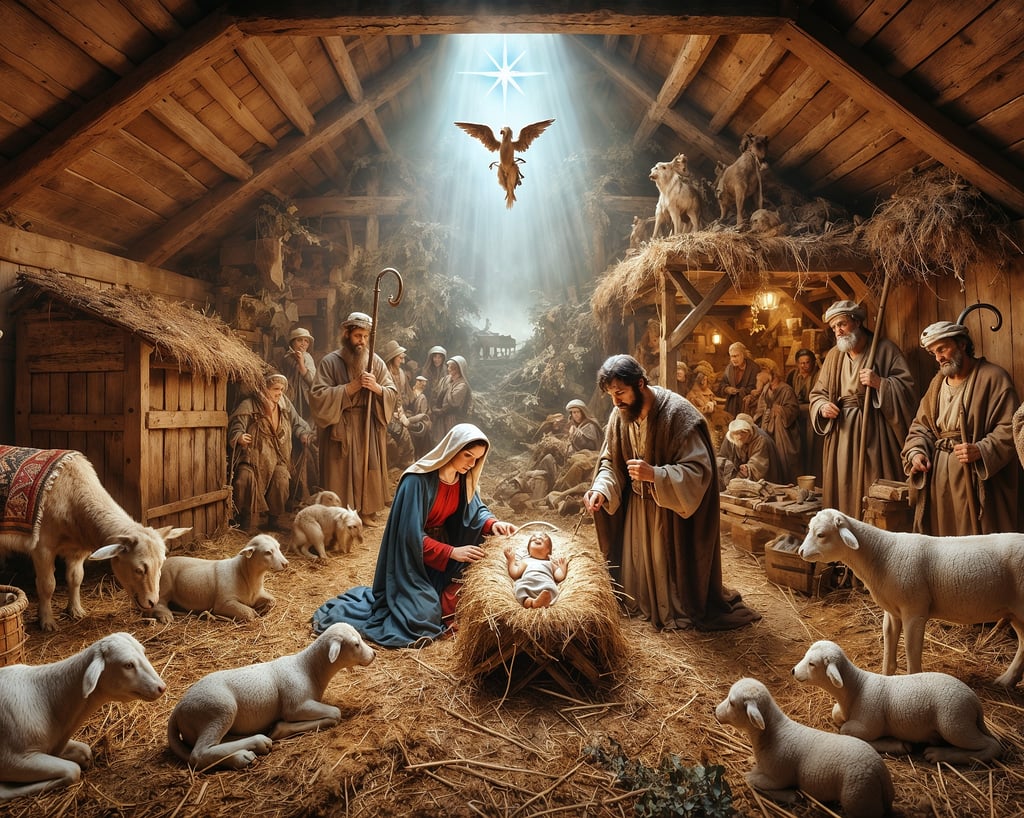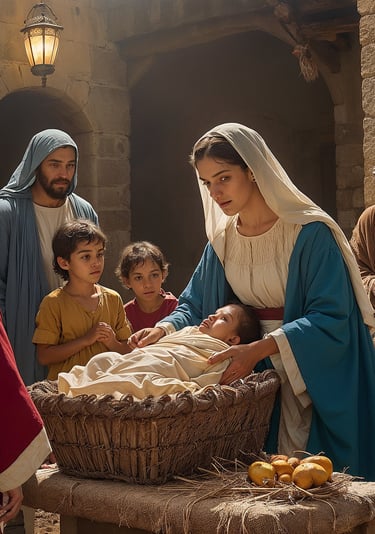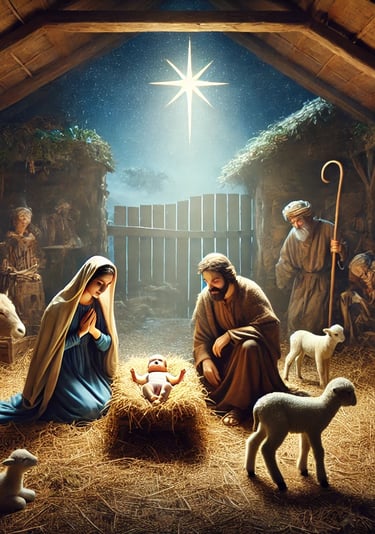The Miraculous Birth of Jesus:
In this heartfelt blog post, journey back to the quiet town of Nazareth, where a young woman named Mary receives an extraordinary visit from the angel Gabriel, setting into motion events that would change the world forever. Follow Mary and Joseph as they navigate divine messages, a challenging journey to Bethlehem, and the miraculous birth of Jesus in a humble stable. Discover the shepherds' divine revelation and the wise men's quest guided by a mysterious star, culminating in their encounter with the newborn king. Through their experiences, this post beautifully captures the essence of faith, hope, and love, showcasing how God works through ordinary lives to fulfil extraordinary prophecies. Dive into this engaging and fluid narrative that brings to life the humble beginnings of Jesus, inspiring readers to see the divine in everyday moments.
7/17/20247 min read


My post content
English
The Miraculous Birth of Jesus: A Journey Through Prophecy and Hope
In the quiet town of Nazareth, a young woman named Mary received an extraordinary visit that would change the world. The angel Gabriel appeared to her, delivering a message of immense joy and responsibility: Mary was chosen to bear a child, Jesus, who would be called the Son of the Most High. Despite the surprising news, Mary's faith was unwavering, and she accepted her divine role with grace.
At the same time, Joseph, her betrothed, faced his own angelic visitation. In a dream, an angel reassured him of Mary's divine pregnancy and instructed him to name the child Jesus, meaning 'the Lord saves'. Joseph, a man of steadfast virtue, embraced his role in this celestial plan, supporting Mary wholeheartedly.
As Mary's pregnancy neared its term, a decree from Caesar Augustus required all residents of the Roman Empire to register in their ancestral towns. For Joseph and Mary, this meant a challenging journey to Bethlehem, the City of David. Arriving exhausted, they found no lodging available, save for a humble stable. There, surrounded by animals and shepherds, Mary gave birth to Jesus, laying him in a manger because there was no crib. This simple beginning fulfilled ancient prophecies and underscored the humility of the one who was to be king.
That same night, nearby shepherds experienced a divine revelation as angels appeared, proclaiming the birth of the Savior. Overwhelmed with joy and curiosity, the shepherds visited the stable, finding Mary, Joseph, and the newborn Jesus exactly as the angels had described. They left the stable with hearts full of joy, spreading the news of the miraculous birth to all who would listen.
Meanwhile, wise men from the East, guided by a mysterious star, embarked on a quest to find the newborn king. Their journey led them to Jerusalem, where King Herod, disturbed by the prophecy of a new ruler, deceitfully asked them to inform him of the child's location under the guise of wanting to worship him. The wise men continued to Bethlehem, where the star led them directly to Jesus. They offered gifts of significant symbolism: gold for a king, frankincense for a deity, and myrrh, foreshadowing his death.
Forewarned in a dream about Herod's wicked intentions, the wise men returned home by another route, avoiding Jerusalem. Joseph, too, was warned by an angel in a dream. He promptly took Mary and Jesus to Egypt, where they stayed until Herod's death. Afterward, fearing Herod's son who now ruled Judea, Joseph moved his family to the safer region of Galilee, settling in the town of Nazareth. This fulfilled yet another prophecy: Jesus would be called a Nazarene.
The birth of Jesus, marked by celestial signs, fulfilled prophecies, and humble beginnings, continues to inspire faith, hope, and love across generations. It reminds us of the profound ways God can work through ordinary lives, inviting us to see the divine in the everyday and the extraordinary in the simple.
Romanien
Nașterea miraculoasă a lui Isus: o călătorie prin profeție și speranță
În orașul liniștit Nazaret, o tânără pe nume Mary a primit o vizită extraordinară care avea să schimbe lumea. Îngerul Gavriil i s-a arătat, dând un mesaj de bucurie și responsabilitate imensă: Maria a fost aleasă pentru a naște un copil, Isus, care avea să fie numit Fiul Celui Prea Înalt. În ciuda veștii surprinzătoare, credința Mariei a fost neclintită și și-a acceptat rolul divin cu har.
În același timp, Iosif, logodnicul ei, s-a confruntat cu propria lui vizită îngerească. Într-un vis, un înger l-a asigurat de sarcina divină a Mariei și l-a instruit să-i numească copilului Isus, adică „Domnul mântuiește”. Iosif, un om cu o virtute statornică, și-a îmbrățișat rolul în acest plan ceresc, sprijinind-o pe Maria din toată inima.
Pe măsură ce sarcina Mariei se apropia de termen, un decret al lui Cezar Augustus cerea tuturor locuitorilor Imperiului Roman să se înregistreze în orașele lor ancestrale. Pentru Iosif și Maria, aceasta a însemnat o călătorie provocatoare până la Betleem, orașul lui David. Ajunși epuizați, nu au găsit nicio cazare disponibilă, cu excepția unui grajd umil. Acolo, înconjurată de animale și păstori, Maria l-a născut pe Isus, culcându-l într-o iesle pentru că nu era pătuț. Acest început simplu a împlinit profețiile străvechi și a subliniat smerenia celui care urma să fie rege.
În aceeași noapte, păstorii din apropiere au experimentat o revelație divină, când îngerii au apărut, proclamând nașterea Mântuitorului. Copleșiți de bucurie și curiozitate, păstorii au vizitat grajdul, găsindu-i pe Maria, Iosif și pe nou-născut Isus exact așa cum i-au descris îngerii. Au părăsit grajdul cu inimile pline de bucurie, răspândind vestea nașterii miraculoase tuturor celor care vor asculta.
Între timp, înțelepții din Est, ghidați de o stea misterioasă, s-au angajat într-o căutare pentru a-l găsi pe rege nou-născut. Călătoria lor i-a condus la Ierusalim, unde regele Irod, tulburat de profeția unui nou conducător, le-a rugat în mod înșelător să-l informeze despre locația copilului sub pretextul că dorește să i se închine. Înțelepții au continuat spre Betleem, unde steaua i-a condus direct la Isus. Ei au oferit cadouri cu un simbolism semnificativ: aur pentru un rege, tămâie pentru o zeitate și smirnă, prevestind moartea lui.
Avertizați într-un vis despre intențiile rele ale lui Irod, înțelepții s-au întors acasă pe o altă cale, evitând Ierusalimul. Și Iosif a fost avertizat de un înger în vis. I-a dus imediat pe Maria și pe Isus în Egipt, unde au rămas până la moartea lui Irod. După aceea, temându-se de fiul lui Irod, care acum conducea Iudeea, Iosif și-a mutat familia în regiunea mai sigură a Galileii, stabilindu-se în orașul Nazaret. Aceasta a împlinit încă o profeție: Isus avea să fie numit Nazarinean.
Nașterea lui Isus, marcată de semne cerești, profeții împlinite și începuturi umile, continuă să inspire credință, speranță și iubire de-a lungul generațiilor. Ne amintește de modurile profunde prin care Dumnezeu poate lucra prin vieți obișnuite, invitându-ne să vedem divinul în cotidian și extraordinarul în simplu.






